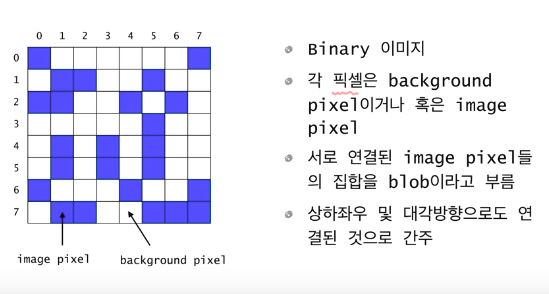인프런의 영리한 프로그래밍을 위한 알고리즘 강좌를 보고 작성한 문서입니다.
Counting Cells in a Blob

-
입력:
-
N*N 크기의 2차원 그리드(grid)
-
하나의 좌표 (x,y)
-
-
출력:
-
픽셀 (x,y)가 포함된 blob의 크기,
-
(x,y)가 어떤 blob에도 속하지 않는 경우에는 0
-
현재 픽셀이 속한 blob의 크기를 카운트 하려면
- Base case: 현재 픽셀이 image color가 아니라면 0을 반환한다.
- Recursice case: 현재 픽셀이 image color라면
-
먼저 현재 픽셀을 카운트 한다(count=1)
-
현재 픽셀이 중복 카운트되는 것을 방지하기 위해 다른 색으로 칠한다.
-
현재 픽셀에 이웃한 모든 픽셀들에 대해서 그 픽셀이 속한 blob의 크기를 카운트하여 카운터에 더해준다.
-
카운터를 반환한다.
수도 코드
Algorithm for countCells(x,y)
if the pixel (x,y) is outside the grid
the result is 0;
else if pixel(x,y) is not an image pixel or already counted
the result is 0;
else
set the colour of the pixel (x,y) to a red colour;
the result is 1 plus the number of cells in each piece of
the blob that includes a nearest neighbour;
-
(x,y) pixel이 배열 범위의 값인지 확인한다. 아니라면 0을 리턴한다.
-
해당 픽셀이 image pixel 또는 이지 count한 픽셀이면 0을 리턴한다.
-
해당 픽셀이 image pixel이면 색을 변경한 후, count + 1을 하고 근처 픽셀들을 재귀적으로 확인한다.
java 코드
private static int BACKGROUND_COLOR = 0;
private static int IMAGE_COLOR = 1;
private static int ALREADY_COUNTED = 2;
public int countCells(int x, int y){
int result;
//배열의 범위인지 확인
if(x<0 || x>N || y<0 || y>=N){
return 0;
}
//이미지 픽셀인지 확인
else if(grid[x][y] != IMAGE_COLOR){
return 0;
}
//해당 픽셀을 ALREADY_COUNTED로 변경후 1을 리턴 하면서 인근 픽셀들에 대해 재귀적으로 조사한다.
else{
grid[x][y] = ALREADY_COUNTED;
return 1 + countCells(x-1, y+1) + countCells(x, y+1) +
countCells(x+1, y+1) + countCells(x-1, y) +
countCells(x+1, y) + countCells(x-1, y-1) +
countCells(x, y-1) + countCells(x+1, y-1);
}
}